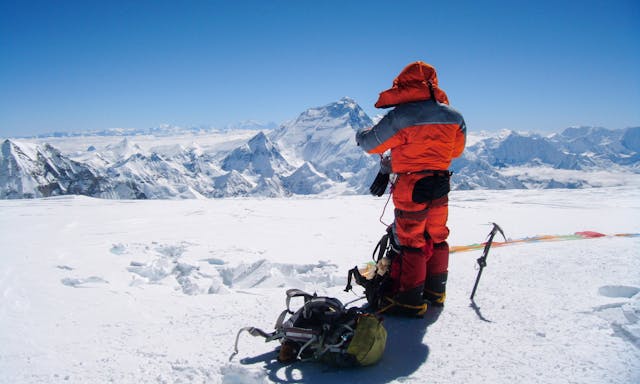Mount Everest, the highest peak in the world, is the ultimate dream for climbers. But reaching the summit isn’t possible without the Sherpas—brave men and women who risk their lives to help climbers conquer the mountain. In this article, we’ll explore the crucial role Sherpas play in Everest expeditions, the dangers they face, and the sacrifices they make.
Who Are the Sherpas?
Sherpas are an ethnic group native to the Solu-Khumbu region in Nepal, near Mount Everest. For centuries, they’ve lived in high-altitude regions, where they’ve developed unique physical and mental strengths that make them perfect for mountain work. Their deep knowledge of the Himalayas and their physical endurance have made them essential to Everest expeditions.
Sherpas are often thought of as “mountain guides,” but they do much more than that. Their work includes carrying supplies, setting up camps, guiding climbers, and even risking their lives during emergencies. Though their work is crucial, Sherpas face immense risks, which are often overlooked.
The Vital Role of Sherpas in Climbing Everest
Sherpas take on numerous important responsibilities during Everest expeditions. Without them, climbers would struggle to make it anywhere near the summit. Here’s how Sherpas help climbers:
1. Preparing the Route
Before climbers even arrive at base camp, Sherpas are already working. They set up base camp, bring supplies from lower camps, and create safe routes for climbers. This preparation is critical for the success of any expedition.
2. Guiding Climbers
Once the climbers reach base camp, Sherpas guide them through Everest’s dangerous terrain. With their expertise, Sherpas lead the way and help climbers stay safe while navigating icefalls, rockfalls, and unpredictable weather.
3. Carrying Heavy Loads
One of the most physically demanding tasks Sherpas face is carrying heavy loads. These can weigh up to 40 kilograms (88 pounds) and include oxygen tanks, food, and climbing gear. Sherpas make multiple trips between camps, often carrying supplies to higher altitudes.
4. Setting Up High-Altitude Camps
Sherpas are also responsible for setting up high-altitude camps, which climbers need for rest and acclimatization. These camps are essential for the climbers’ survival at such high elevations. Sherpas work tirelessly to ensure the camps are ready for climbers to rest and recover before making their summit attempt.
5. Rescue Operations
In emergencies, Sherpas are often the first to respond. Their deep knowledge of the mountain allows them to act quickly and save lives. Many times, they put their own lives at risk to rescue climbers who are stranded or in danger.
The Dangers Sherpas Face
Climbing Everest is incredibly dangerous, but Sherpas face even greater risks. They work in extreme conditions and often find themselves in life-threatening situations. Here are some of the dangers Sherpas face:
1. Avalanches
Avalanches are a constant threat on Everest. Sherpas work in high-risk areas, such as the Khumbu Icefall, where avalanches can strike suddenly. Even with their expertise, Sherpas are still vulnerable to this deadly danger.
2. Altitude Sickness
While climbers are often affected by altitude sickness, Sherpas are not immune. They may suffer from headaches, dizziness, and more severe conditions like pulmonary edema. These issues are life-threatening, especially at such high altitudes.
3. Falling Rocks and Ice
The terrain on Everest is unstable, with rocks and icefalls that can fall without warning. Sherpas are sometimes in the direct path of these falling objects. They risk injury or death every day while carrying out their work.
4. Extreme Weather
Everest’s weather is unpredictable. Sherpas frequently work in freezing temperatures, snowstorms, and high winds. These harsh conditions can lead to frostbite and hypothermia, making their work even more dangerous.
5. Physical Exhaustion
Sherpas carry heavy loads up and down the mountain, often multiple times a day. This takes a serious toll on their bodies. With little rest and extreme physical strain, Sherpas face exhaustion and injury as a constant risk.
The Price of Sacrifice: Sherpas Losing Their Lives
Despite the risks, Sherpas continue to guide climbers up Mount Everest. However, the toll is high. Every year, several Sherpas lose their lives in accidents on the mountain. In 2014, an avalanche in the Khumbu Icefall killed 16 Sherpas, drawing international attention to their sacrifices. This tragedy was a reminder of the immense danger they face, but Sherpas continue to return year after year to help climbers.
The Ethics of Everest Climbing
As more and more climbers attempt to summit Everest, issues of overcrowding and commercialization have arisen. Sherpas have voiced concerns over the growing number of tourists on the mountain. Many climbers lack the necessary skills, which increases the risk for both climbers and Sherpas.
Sherpas are also advocating for better pay, improved working conditions, and recognition for their efforts. While climbers often pay large sums to reach the summit, Sherpas receive far less for the dangerous work they do. It’s essential that the mountaineering community provides better support for Sherpas and ensures their safety.
Conclusion: Honoring Sherpas’ Contributions
Sherpas are the true heroes of Mount Everest. Their strength, courage, and unwavering commitment enable climbers to reach the summit, even though they face extreme risks and dangers. Every year, Sherpas put their lives on the line to help others achieve their dreams of conquering the world’s tallest mountain.
It’s time for the world to recognize and appreciate the sacrifices Sherpas make. Their contributions are invaluable, and without them, the Everest climbing industry would not exist. By acknowledging their work and ensuring better conditions for them, we can help honor their bravery and keep them safe for generations to come.
In memory of the sherpas we had made an article about a mount Everest tragedy in 2015: Click here to read it.

